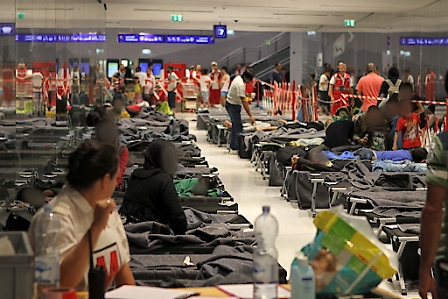Erstellt am: 1. 9. 2015 - 14:55 Uhr
Getting there?
The flow of refugees through Hungary to Austria and then on to Germany seems to have caught the European Union on the back foot. We’ve seen unprecedented scenes at train stations in Budapest and then Vienna, waves of trains full of refugees, spontaneous initiatives by private individuals to organise water and food, and station food stores sold out of supplies.

EPA/FMT-PICTURES/PM
In spite of the barbed wire fence being built by Hungary police have been letting people cross the border from Serbia. On Monday refugees were allowed to board trains heading for Vienna. On Tuesday the railway station in Budapest was closed and evacuated, and then reopened an hour later, but migrants were not being allowed to enter.

EPA/ZOLTAN BALOGH
The Austrian police say under the “Dublin III” regulation, most people arriving in Austria illegally should have been arrested and sent back to the first EU country they arrived in – Hungary – yet those who haven’t applied for asylum in Austria have been allowed to travel on to Germany. Police spokesman Roman Haslinger said it just wasn’t feasible under the circumstances to carry out checks.

EPA/NICOLAS ARMER

Riem Higazi
The German Chancellor Angela Merkel, who’s been accused of having been too reticent on the refugee crisis, on Monday delivered a rousing speech to journalists, saying that Europe must do more, and that in the face of this humanitarian crisis, Germany has a responsibility to act and to take in refugees.
Chancellor Werner Faymann, in Monday night’s “Sommergespräch”, had harsh words for Hungary as well as for EU member states rejecting the idea of quota system for refugees, while at Monday's "Mensch in Österreich sein" demonstration in Vienna, some people carried signs with the word "Dublin" crossed out.
John Cummins reports on the developments at the Westbahnhof in Vienna and Sandra Gathmann gives us the perspective from Brussels:
Dieses Element ist nicht mehr verfügbar
Dieses Element ist nicht mehr verfügbar


